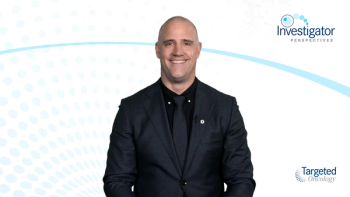
Second-line Treatment Options for R/R FL Patients
Loretta Nastoupil, MD, describes the challenges of selecting treatment beyond the second-line.
Episodes in this series

Loretta Nastoupil, MD: Because most patients with this disease will experience multiple recurrences over the course of their lifetime, it’s important to manage expectations and be on the lookout for signs and symptoms of recurrent follicular lymphoma. In the second-line setting, common strategies include altering the chemoimmunotherapy approach, because many patients will receive bendamustine plus a CD20 in the front line. It is not infrequent that patients might receive CHOP [cyclophosphamide, doxorubicin, vincristine, prednisone]-based therapy or CVP [cyclophosphamide, vincristine and prednisolone]-based therapy in combination with a CD20 antibody, similar to this case.
In the absence of transformed disease, it’s also reasonable to consider a targeted approach. Lenalidomide in combination with rituximab was significantly better than rituximab monotherapy in regard to progression-free survival in the AUGMENT study. There was even an overall survival advantage among patients with follicular lymphoma. The common strategy in my clinical practice is to consider lenalidomide and rituximab in that second-line setting, particularly among patients in whom rituximab monotherapy might be a consideration. These are patients with no clinical concern for transformed disease.
Once you get into the third-line space, you have more options. In that space, we’ve had PI3 kinase inhibitors approved for years now. The potential downside to a PI3 kinase inhibitor is that these patients are treated until progression or intolerance, and the toxicity profile with some of the PI3 kinase inhibitors can be challenging with cumulative toxicity over time. There are strategies underway looking at intermittent dosing, particularly with things like copanlisib, that might overcome some of these limitations. The safety profile may have hindered some of the uptake of PI3 kinase inhibitors in the third-line or later space.
Tazemetostat is approved in this space for patients with an EZH2 mutation or those who are wild type or it’s unknown, particularly given that the safety profile is considered favorable with very low rates of grade 3 or higher toxicity. There are very low rates of treatment discontinuation as a result of toxicity. Recently approved is axicabtagene ciloleucel, which is an autologous CD19 CAR [chimeric antigen receptor] T-cell therapy for relapsed follicular lymphoma in the third-line or later space. Given the toxicity profile and the logistical constraints surrounding CAR T-cell therapy, it will likely be utilized in a subgroup of patients who have either POD24 [progression of disease within 24 months], or where there’s clinical concern for transformed disease, such as a rapidly progressing tumor, elevated LDH [lactate dehydrogenase], elevated calcium, or heavy symptom burden. However, it has not been proven on pathology. There is a role for CAR T for some of these patients, but it will be a subgroup. Tazemetostat offers a tolerable therapy. It’s an oral therapy that will potentially provide new treatment options, particularly for patients in whom a PI3 kinase inhibitor has either failed or is not desirable.
This transcript has been edited for clarity.
Case: A 75-Year-Old Woman With Relapsed/Refractory Follicular Lymphoma
Initial presentation
- A 75-year-old woman complains of a 3-month history of fatigue, occasional fevers, decreased appetite, fatigue, and a 12-lb weight loss
- PMH: Medically-controlled hypertension, osteoporosis, hypercholesterolemia managed with diet and exercise
- PE: palpable bilateral axillary and left cervical lymph nodes, ~ 3 cm in both axillae and 2 cm in the cervical nodes; spleen palpable 4 cm below left costal margin
Clinical workup
- Labs: ANC 1.6 x 109/L, WBC 11.4 x 109/L, 43% lymphocytes, Hb 9.8 g/dL, plt 98 x 109/L, LDH 325 U/L, B2M 3.7 µg/mL; HBV negative
- Excisional biopsy of the axillary lymph node on IHC showed CD 20+, CD 3+, CD5+, CD 10+, BCL2+; follicular lymphoma grade 2
- Bone marrow biopsy showed paratrabecular lymphoid aggregates, 42% involvement
- Cytogenetics: t(14;18) (q32;q21)
- Molecular testing: EZH2m+
- PET/CT showed bilateral axillary, left cervical, and mediastinal lymphadenopathy (3.3 cm, 3.1, cm and 4.6 cm respectively)
- Ann Arbor Stage IV; ECOG 1
Treatment
- She was treated with bendamustine and rituximab for 6 cycles, achieved partial response and continued rituximab maintenance
- 24 months later she complained of ULQ discomfort, loss of appetite, fevers new onset itching; she was currently taking antibiotics for her 2nd bacterial infection in the past 6 months
- Repeat PET/CT revealed progression of disease
- She was started on R-CHOP for 6 cycles and continued on rituximab maintenance
- Repeat lymph node biopsy grade 2 follicular lymphoma
- 12 months later she complained of continued weight loss, increased itching and worsening fatigue; recurrent infections continued
- She was started on tazemetostat 800 mg BID








































